Industrial Relations Climate
VerifiedAdded on 2023/04/21
|11
|2925
|91
AI Summary
This paper discusses the concept of industrial relations climate and its impact on organizational changes. It explores different perspectives such as pluralism, neo-liberalism, Marxism, and feminism. The case study of Australia Post is used to illustrate the implementation of these perspectives. The paper highlights the benefits and challenges of each perspective and concludes with the importance of improving employer-employee relations.
Contribute Materials
Your contribution can guide someone’s learning journey. Share your
documents today.
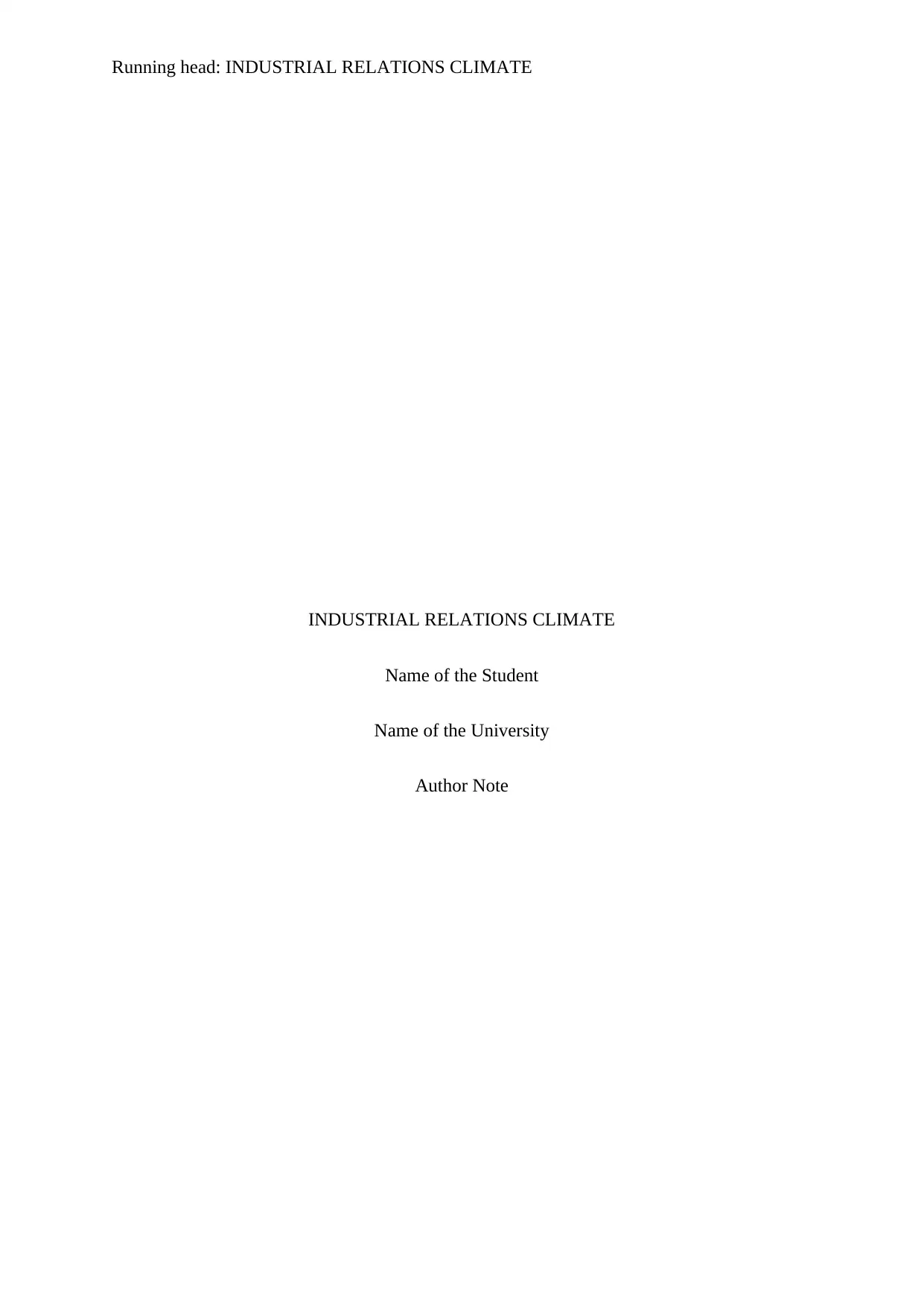
Running head: INDUSTRIAL RELATIONS CLIMATE
INDUSTRIAL RELATIONS CLIMATE
Name of the Student
Name of the University
Author Note
INDUSTRIAL RELATIONS CLIMATE
Name of the Student
Name of the University
Author Note
Secure Best Marks with AI Grader
Need help grading? Try our AI Grader for instant feedback on your assignments.
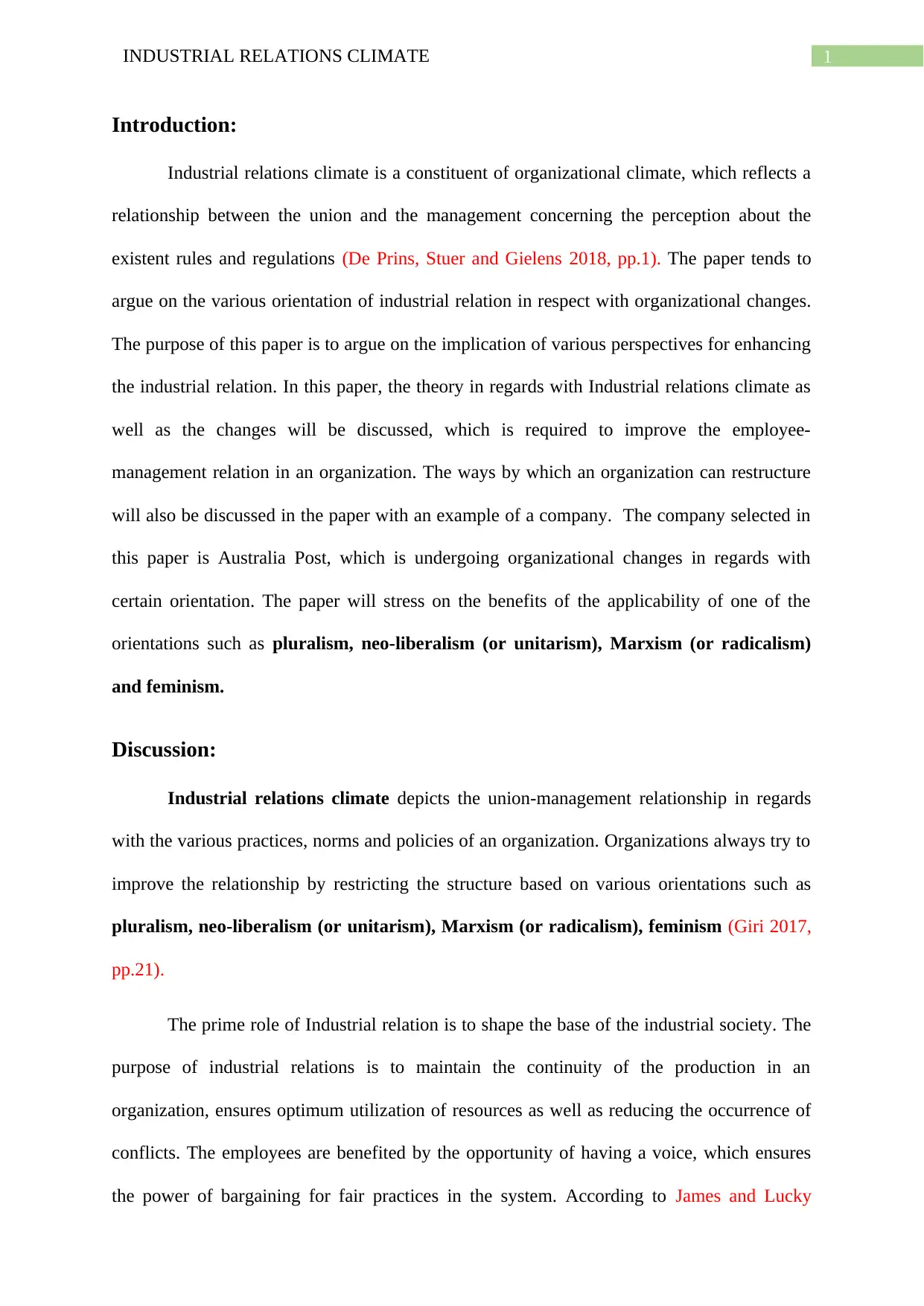
1INDUSTRIAL RELATIONS CLIMATE
Introduction:
Industrial relations climate is a constituent of organizational climate, which reflects a
relationship between the union and the management concerning the perception about the
existent rules and regulations (De Prins, Stuer and Gielens 2018, pp.1). The paper tends to
argue on the various orientation of industrial relation in respect with organizational changes.
The purpose of this paper is to argue on the implication of various perspectives for enhancing
the industrial relation. In this paper, the theory in regards with Industrial relations climate as
well as the changes will be discussed, which is required to improve the employee-
management relation in an organization. The ways by which an organization can restructure
will also be discussed in the paper with an example of a company. The company selected in
this paper is Australia Post, which is undergoing organizational changes in regards with
certain orientation. The paper will stress on the benefits of the applicability of one of the
orientations such as pluralism, neo-liberalism (or unitarism), Marxism (or radicalism)
and feminism.
Discussion:
Industrial relations climate depicts the union-management relationship in regards
with the various practices, norms and policies of an organization. Organizations always try to
improve the relationship by restricting the structure based on various orientations such as
pluralism, neo-liberalism (or unitarism), Marxism (or radicalism), feminism (Giri 2017,
pp.21).
The prime role of Industrial relation is to shape the base of the industrial society. The
purpose of industrial relations is to maintain the continuity of the production in an
organization, ensures optimum utilization of resources as well as reducing the occurrence of
conflicts. The employees are benefited by the opportunity of having a voice, which ensures
the power of bargaining for fair practices in the system. According to James and Lucky
Introduction:
Industrial relations climate is a constituent of organizational climate, which reflects a
relationship between the union and the management concerning the perception about the
existent rules and regulations (De Prins, Stuer and Gielens 2018, pp.1). The paper tends to
argue on the various orientation of industrial relation in respect with organizational changes.
The purpose of this paper is to argue on the implication of various perspectives for enhancing
the industrial relation. In this paper, the theory in regards with Industrial relations climate as
well as the changes will be discussed, which is required to improve the employee-
management relation in an organization. The ways by which an organization can restructure
will also be discussed in the paper with an example of a company. The company selected in
this paper is Australia Post, which is undergoing organizational changes in regards with
certain orientation. The paper will stress on the benefits of the applicability of one of the
orientations such as pluralism, neo-liberalism (or unitarism), Marxism (or radicalism)
and feminism.
Discussion:
Industrial relations climate depicts the union-management relationship in regards
with the various practices, norms and policies of an organization. Organizations always try to
improve the relationship by restricting the structure based on various orientations such as
pluralism, neo-liberalism (or unitarism), Marxism (or radicalism), feminism (Giri 2017,
pp.21).
The prime role of Industrial relation is to shape the base of the industrial society. The
purpose of industrial relations is to maintain the continuity of the production in an
organization, ensures optimum utilization of resources as well as reducing the occurrence of
conflicts. The employees are benefited by the opportunity of having a voice, which ensures
the power of bargaining for fair practices in the system. According to James and Lucky
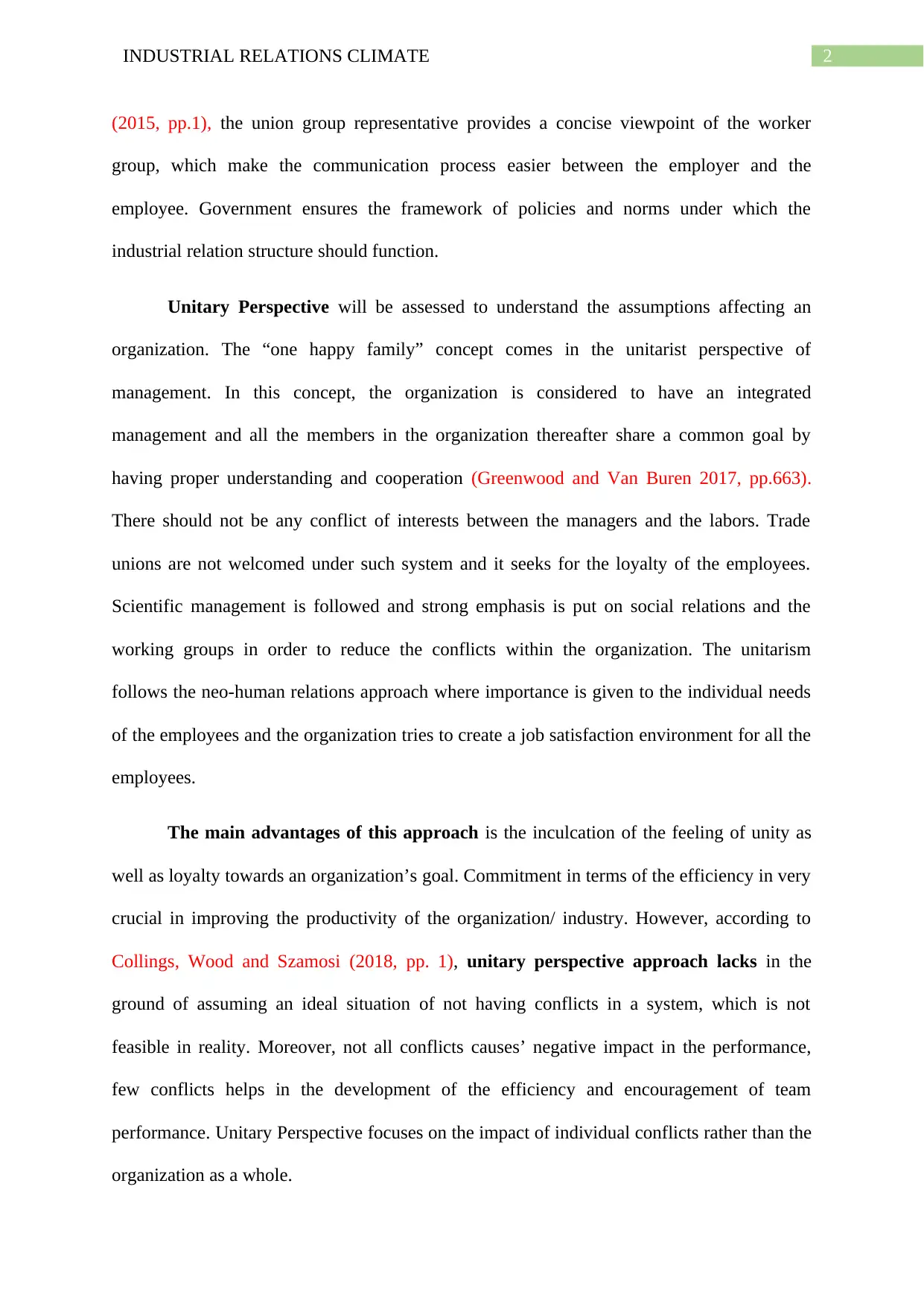
2INDUSTRIAL RELATIONS CLIMATE
(2015, pp.1), the union group representative provides a concise viewpoint of the worker
group, which make the communication process easier between the employer and the
employee. Government ensures the framework of policies and norms under which the
industrial relation structure should function.
Unitary Perspective will be assessed to understand the assumptions affecting an
organization. The “one happy family” concept comes in the unitarist perspective of
management. In this concept, the organization is considered to have an integrated
management and all the members in the organization thereafter share a common goal by
having proper understanding and cooperation (Greenwood and Van Buren 2017, pp.663).
There should not be any conflict of interests between the managers and the labors. Trade
unions are not welcomed under such system and it seeks for the loyalty of the employees.
Scientific management is followed and strong emphasis is put on social relations and the
working groups in order to reduce the conflicts within the organization. The unitarism
follows the neo-human relations approach where importance is given to the individual needs
of the employees and the organization tries to create a job satisfaction environment for all the
employees.
The main advantages of this approach is the inculcation of the feeling of unity as
well as loyalty towards an organization’s goal. Commitment in terms of the efficiency in very
crucial in improving the productivity of the organization/ industry. However, according to
Collings, Wood and Szamosi (2018, pp. 1), unitary perspective approach lacks in the
ground of assuming an ideal situation of not having conflicts in a system, which is not
feasible in reality. Moreover, not all conflicts causes’ negative impact in the performance,
few conflicts helps in the development of the efficiency and encouragement of team
performance. Unitary Perspective focuses on the impact of individual conflicts rather than the
organization as a whole.
(2015, pp.1), the union group representative provides a concise viewpoint of the worker
group, which make the communication process easier between the employer and the
employee. Government ensures the framework of policies and norms under which the
industrial relation structure should function.
Unitary Perspective will be assessed to understand the assumptions affecting an
organization. The “one happy family” concept comes in the unitarist perspective of
management. In this concept, the organization is considered to have an integrated
management and all the members in the organization thereafter share a common goal by
having proper understanding and cooperation (Greenwood and Van Buren 2017, pp.663).
There should not be any conflict of interests between the managers and the labors. Trade
unions are not welcomed under such system and it seeks for the loyalty of the employees.
Scientific management is followed and strong emphasis is put on social relations and the
working groups in order to reduce the conflicts within the organization. The unitarism
follows the neo-human relations approach where importance is given to the individual needs
of the employees and the organization tries to create a job satisfaction environment for all the
employees.
The main advantages of this approach is the inculcation of the feeling of unity as
well as loyalty towards an organization’s goal. Commitment in terms of the efficiency in very
crucial in improving the productivity of the organization/ industry. However, according to
Collings, Wood and Szamosi (2018, pp. 1), unitary perspective approach lacks in the
ground of assuming an ideal situation of not having conflicts in a system, which is not
feasible in reality. Moreover, not all conflicts causes’ negative impact in the performance,
few conflicts helps in the development of the efficiency and encouragement of team
performance. Unitary Perspective focuses on the impact of individual conflicts rather than the
organization as a whole.
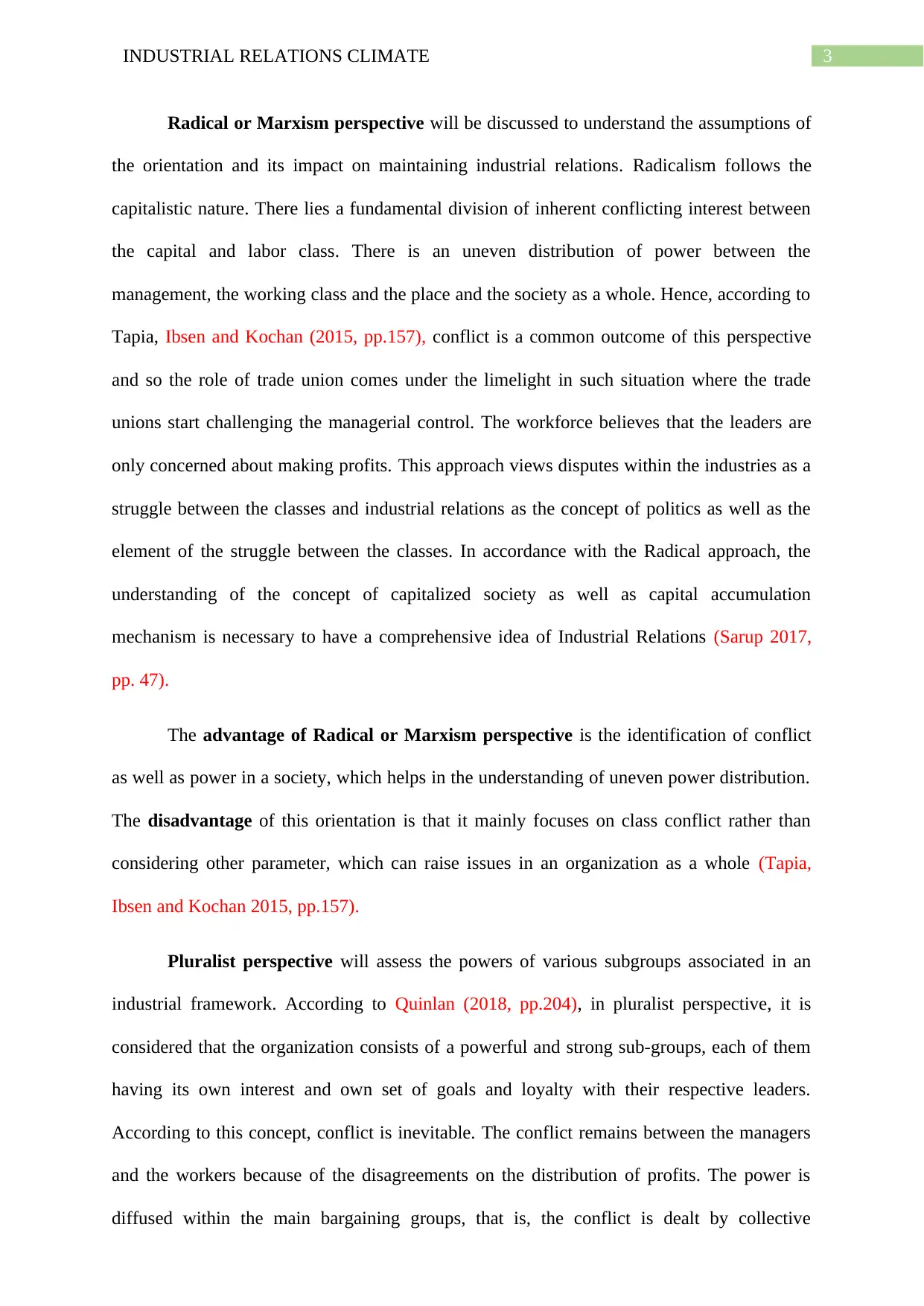
3INDUSTRIAL RELATIONS CLIMATE
Radical or Marxism perspective will be discussed to understand the assumptions of
the orientation and its impact on maintaining industrial relations. Radicalism follows the
capitalistic nature. There lies a fundamental division of inherent conflicting interest between
the capital and labor class. There is an uneven distribution of power between the
management, the working class and the place and the society as a whole. Hence, according to
Tapia, Ibsen and Kochan (2015, pp.157), conflict is a common outcome of this perspective
and so the role of trade union comes under the limelight in such situation where the trade
unions start challenging the managerial control. The workforce believes that the leaders are
only concerned about making profits. This approach views disputes within the industries as a
struggle between the classes and industrial relations as the concept of politics as well as the
element of the struggle between the classes. In accordance with the Radical approach, the
understanding of the concept of capitalized society as well as capital accumulation
mechanism is necessary to have a comprehensive idea of Industrial Relations (Sarup 2017,
pp. 47).
The advantage of Radical or Marxism perspective is the identification of conflict
as well as power in a society, which helps in the understanding of uneven power distribution.
The disadvantage of this orientation is that it mainly focuses on class conflict rather than
considering other parameter, which can raise issues in an organization as a whole (Tapia,
Ibsen and Kochan 2015, pp.157).
Pluralist perspective will assess the powers of various subgroups associated in an
industrial framework. According to Quinlan (2018, pp.204), in pluralist perspective, it is
considered that the organization consists of a powerful and strong sub-groups, each of them
having its own interest and own set of goals and loyalty with their respective leaders.
According to this concept, conflict is inevitable. The conflict remains between the managers
and the workers because of the disagreements on the distribution of profits. The power is
diffused within the main bargaining groups, that is, the conflict is dealt by collective
Radical or Marxism perspective will be discussed to understand the assumptions of
the orientation and its impact on maintaining industrial relations. Radicalism follows the
capitalistic nature. There lies a fundamental division of inherent conflicting interest between
the capital and labor class. There is an uneven distribution of power between the
management, the working class and the place and the society as a whole. Hence, according to
Tapia, Ibsen and Kochan (2015, pp.157), conflict is a common outcome of this perspective
and so the role of trade union comes under the limelight in such situation where the trade
unions start challenging the managerial control. The workforce believes that the leaders are
only concerned about making profits. This approach views disputes within the industries as a
struggle between the classes and industrial relations as the concept of politics as well as the
element of the struggle between the classes. In accordance with the Radical approach, the
understanding of the concept of capitalized society as well as capital accumulation
mechanism is necessary to have a comprehensive idea of Industrial Relations (Sarup 2017,
pp. 47).
The advantage of Radical or Marxism perspective is the identification of conflict
as well as power in a society, which helps in the understanding of uneven power distribution.
The disadvantage of this orientation is that it mainly focuses on class conflict rather than
considering other parameter, which can raise issues in an organization as a whole (Tapia,
Ibsen and Kochan 2015, pp.157).
Pluralist perspective will assess the powers of various subgroups associated in an
industrial framework. According to Quinlan (2018, pp.204), in pluralist perspective, it is
considered that the organization consists of a powerful and strong sub-groups, each of them
having its own interest and own set of goals and loyalty with their respective leaders.
According to this concept, conflict is inevitable. The conflict remains between the managers
and the workers because of the disagreements on the distribution of profits. The power is
diffused within the main bargaining groups, that is, the conflict is dealt by collective
Secure Best Marks with AI Grader
Need help grading? Try our AI Grader for instant feedback on your assignments.
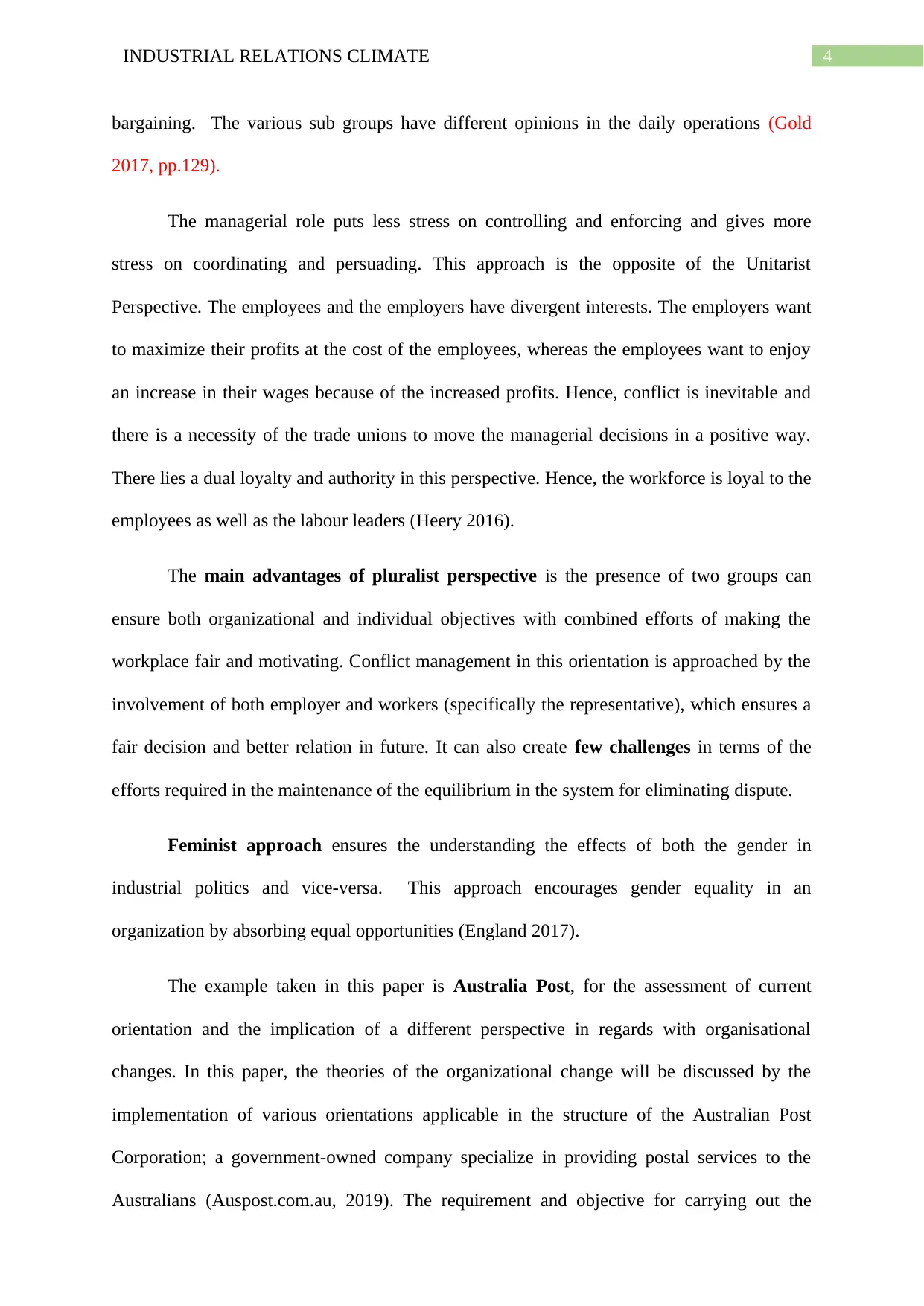
4INDUSTRIAL RELATIONS CLIMATE
bargaining. The various sub groups have different opinions in the daily operations (Gold
2017, pp.129).
The managerial role puts less stress on controlling and enforcing and gives more
stress on coordinating and persuading. This approach is the opposite of the Unitarist
Perspective. The employees and the employers have divergent interests. The employers want
to maximize their profits at the cost of the employees, whereas the employees want to enjoy
an increase in their wages because of the increased profits. Hence, conflict is inevitable and
there is a necessity of the trade unions to move the managerial decisions in a positive way.
There lies a dual loyalty and authority in this perspective. Hence, the workforce is loyal to the
employees as well as the labour leaders (Heery 2016).
The main advantages of pluralist perspective is the presence of two groups can
ensure both organizational and individual objectives with combined efforts of making the
workplace fair and motivating. Conflict management in this orientation is approached by the
involvement of both employer and workers (specifically the representative), which ensures a
fair decision and better relation in future. It can also create few challenges in terms of the
efforts required in the maintenance of the equilibrium in the system for eliminating dispute.
Feminist approach ensures the understanding the effects of both the gender in
industrial politics and vice-versa. This approach encourages gender equality in an
organization by absorbing equal opportunities (England 2017).
The example taken in this paper is Australia Post, for the assessment of current
orientation and the implication of a different perspective in regards with organisational
changes. In this paper, the theories of the organizational change will be discussed by the
implementation of various orientations applicable in the structure of the Australian Post
Corporation; a government-owned company specialize in providing postal services to the
Australians (Auspost.com.au, 2019). The requirement and objective for carrying out the
bargaining. The various sub groups have different opinions in the daily operations (Gold
2017, pp.129).
The managerial role puts less stress on controlling and enforcing and gives more
stress on coordinating and persuading. This approach is the opposite of the Unitarist
Perspective. The employees and the employers have divergent interests. The employers want
to maximize their profits at the cost of the employees, whereas the employees want to enjoy
an increase in their wages because of the increased profits. Hence, conflict is inevitable and
there is a necessity of the trade unions to move the managerial decisions in a positive way.
There lies a dual loyalty and authority in this perspective. Hence, the workforce is loyal to the
employees as well as the labour leaders (Heery 2016).
The main advantages of pluralist perspective is the presence of two groups can
ensure both organizational and individual objectives with combined efforts of making the
workplace fair and motivating. Conflict management in this orientation is approached by the
involvement of both employer and workers (specifically the representative), which ensures a
fair decision and better relation in future. It can also create few challenges in terms of the
efforts required in the maintenance of the equilibrium in the system for eliminating dispute.
Feminist approach ensures the understanding the effects of both the gender in
industrial politics and vice-versa. This approach encourages gender equality in an
organization by absorbing equal opportunities (England 2017).
The example taken in this paper is Australia Post, for the assessment of current
orientation and the implication of a different perspective in regards with organisational
changes. In this paper, the theories of the organizational change will be discussed by the
implementation of various orientations applicable in the structure of the Australian Post
Corporation; a government-owned company specialize in providing postal services to the
Australians (Auspost.com.au, 2019). The requirement and objective for carrying out the
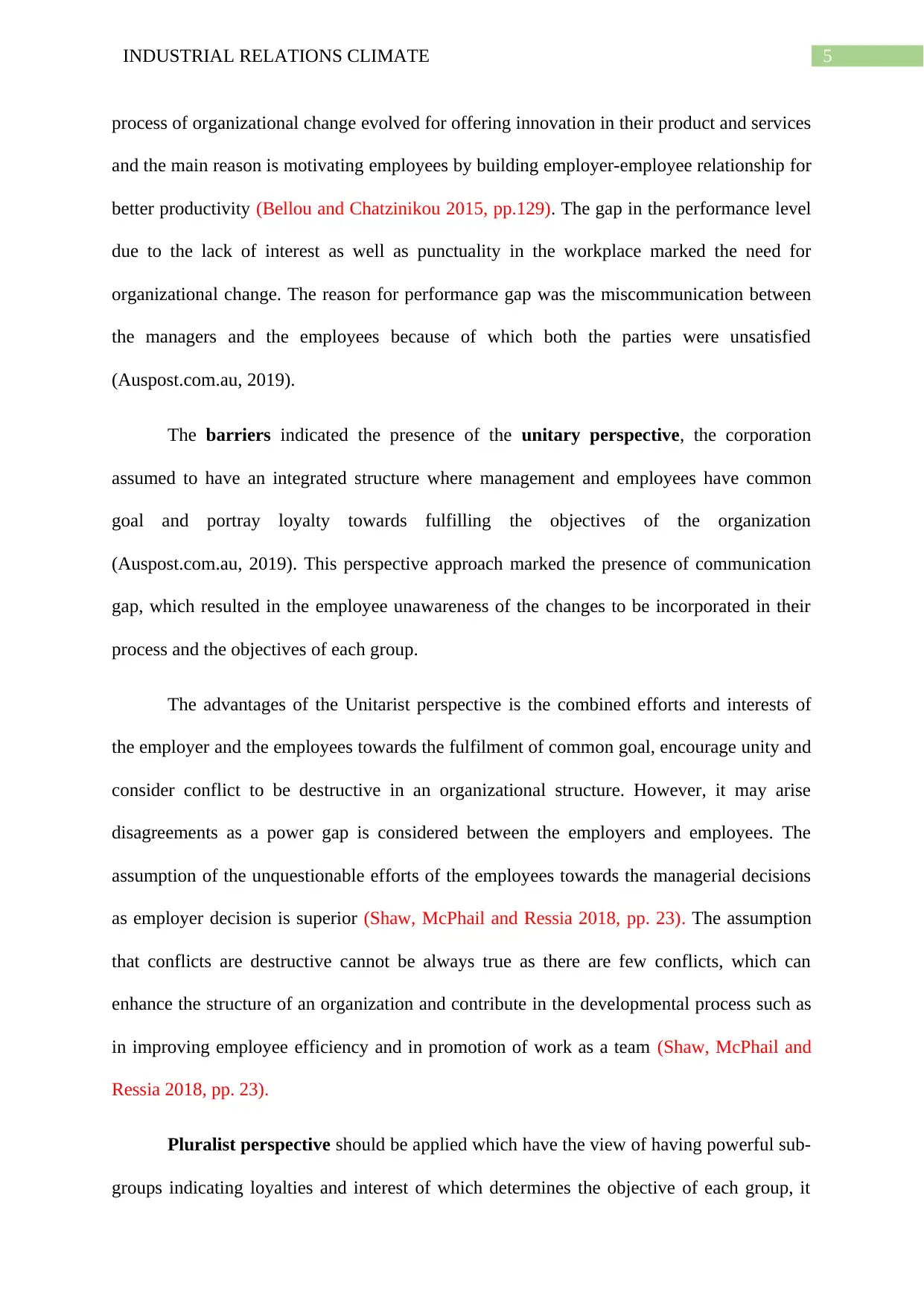
5INDUSTRIAL RELATIONS CLIMATE
process of organizational change evolved for offering innovation in their product and services
and the main reason is motivating employees by building employer-employee relationship for
better productivity (Bellou and Chatzinikou 2015, pp.129). The gap in the performance level
due to the lack of interest as well as punctuality in the workplace marked the need for
organizational change. The reason for performance gap was the miscommunication between
the managers and the employees because of which both the parties were unsatisfied
(Auspost.com.au, 2019).
The barriers indicated the presence of the unitary perspective, the corporation
assumed to have an integrated structure where management and employees have common
goal and portray loyalty towards fulfilling the objectives of the organization
(Auspost.com.au, 2019). This perspective approach marked the presence of communication
gap, which resulted in the employee unawareness of the changes to be incorporated in their
process and the objectives of each group.
The advantages of the Unitarist perspective is the combined efforts and interests of
the employer and the employees towards the fulfilment of common goal, encourage unity and
consider conflict to be destructive in an organizational structure. However, it may arise
disagreements as a power gap is considered between the employers and employees. The
assumption of the unquestionable efforts of the employees towards the managerial decisions
as employer decision is superior (Shaw, McPhail and Ressia 2018, pp. 23). The assumption
that conflicts are destructive cannot be always true as there are few conflicts, which can
enhance the structure of an organization and contribute in the developmental process such as
in improving employee efficiency and in promotion of work as a team (Shaw, McPhail and
Ressia 2018, pp. 23).
Pluralist perspective should be applied which have the view of having powerful sub-
groups indicating loyalties and interest of which determines the objective of each group, it
process of organizational change evolved for offering innovation in their product and services
and the main reason is motivating employees by building employer-employee relationship for
better productivity (Bellou and Chatzinikou 2015, pp.129). The gap in the performance level
due to the lack of interest as well as punctuality in the workplace marked the need for
organizational change. The reason for performance gap was the miscommunication between
the managers and the employees because of which both the parties were unsatisfied
(Auspost.com.au, 2019).
The barriers indicated the presence of the unitary perspective, the corporation
assumed to have an integrated structure where management and employees have common
goal and portray loyalty towards fulfilling the objectives of the organization
(Auspost.com.au, 2019). This perspective approach marked the presence of communication
gap, which resulted in the employee unawareness of the changes to be incorporated in their
process and the objectives of each group.
The advantages of the Unitarist perspective is the combined efforts and interests of
the employer and the employees towards the fulfilment of common goal, encourage unity and
consider conflict to be destructive in an organizational structure. However, it may arise
disagreements as a power gap is considered between the employers and employees. The
assumption of the unquestionable efforts of the employees towards the managerial decisions
as employer decision is superior (Shaw, McPhail and Ressia 2018, pp. 23). The assumption
that conflicts are destructive cannot be always true as there are few conflicts, which can
enhance the structure of an organization and contribute in the developmental process such as
in improving employee efficiency and in promotion of work as a team (Shaw, McPhail and
Ressia 2018, pp. 23).
Pluralist perspective should be applied which have the view of having powerful sub-
groups indicating loyalties and interest of which determines the objective of each group, it
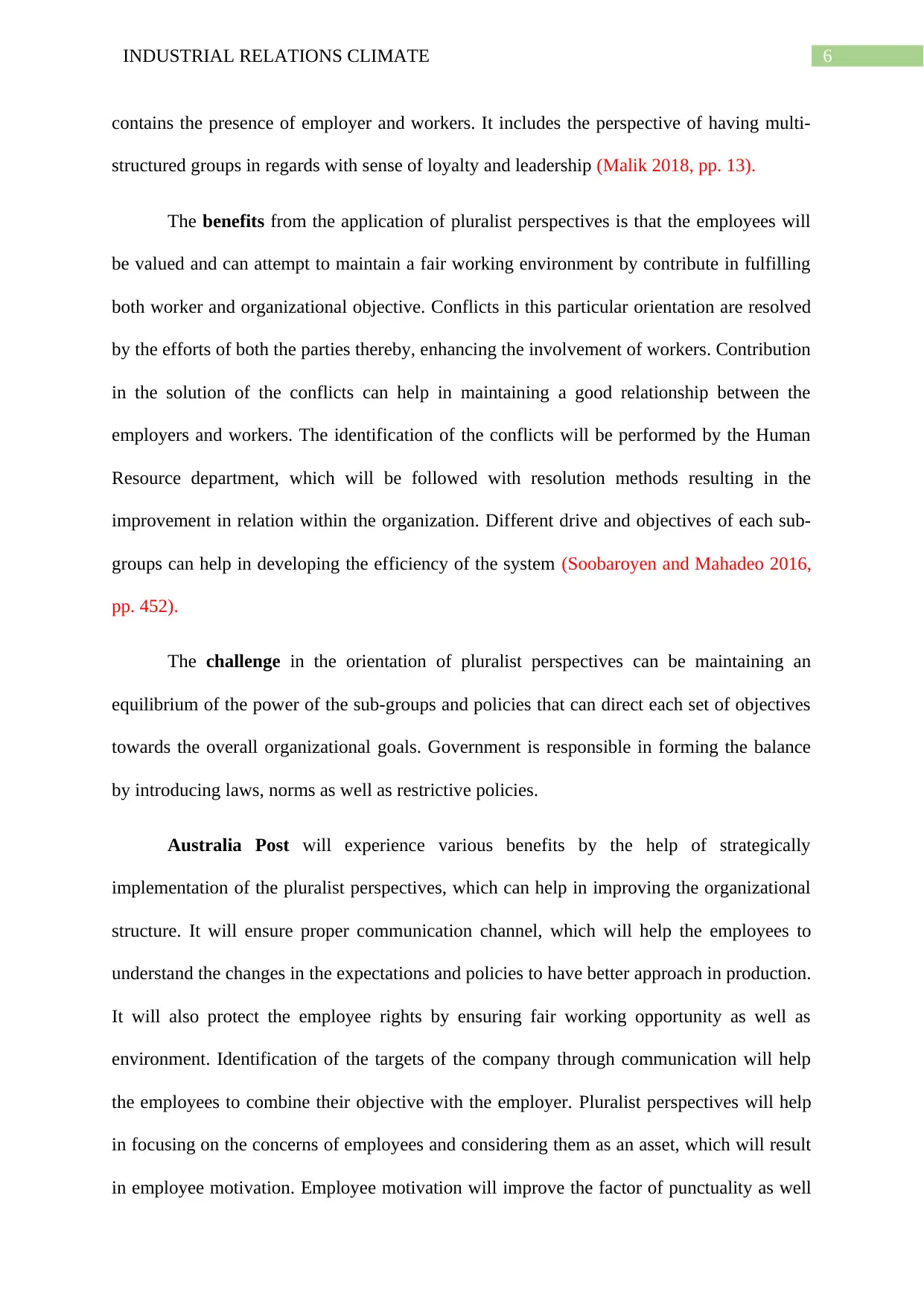
6INDUSTRIAL RELATIONS CLIMATE
contains the presence of employer and workers. It includes the perspective of having multi-
structured groups in regards with sense of loyalty and leadership (Malik 2018, pp. 13).
The benefits from the application of pluralist perspectives is that the employees will
be valued and can attempt to maintain a fair working environment by contribute in fulfilling
both worker and organizational objective. Conflicts in this particular orientation are resolved
by the efforts of both the parties thereby, enhancing the involvement of workers. Contribution
in the solution of the conflicts can help in maintaining a good relationship between the
employers and workers. The identification of the conflicts will be performed by the Human
Resource department, which will be followed with resolution methods resulting in the
improvement in relation within the organization. Different drive and objectives of each sub-
groups can help in developing the efficiency of the system (Soobaroyen and Mahadeo 2016,
pp. 452).
The challenge in the orientation of pluralist perspectives can be maintaining an
equilibrium of the power of the sub-groups and policies that can direct each set of objectives
towards the overall organizational goals. Government is responsible in forming the balance
by introducing laws, norms as well as restrictive policies.
Australia Post will experience various benefits by the help of strategically
implementation of the pluralist perspectives, which can help in improving the organizational
structure. It will ensure proper communication channel, which will help the employees to
understand the changes in the expectations and policies to have better approach in production.
It will also protect the employee rights by ensuring fair working opportunity as well as
environment. Identification of the targets of the company through communication will help
the employees to combine their objective with the employer. Pluralist perspectives will help
in focusing on the concerns of employees and considering them as an asset, which will result
in employee motivation. Employee motivation will improve the factor of punctuality as well
contains the presence of employer and workers. It includes the perspective of having multi-
structured groups in regards with sense of loyalty and leadership (Malik 2018, pp. 13).
The benefits from the application of pluralist perspectives is that the employees will
be valued and can attempt to maintain a fair working environment by contribute in fulfilling
both worker and organizational objective. Conflicts in this particular orientation are resolved
by the efforts of both the parties thereby, enhancing the involvement of workers. Contribution
in the solution of the conflicts can help in maintaining a good relationship between the
employers and workers. The identification of the conflicts will be performed by the Human
Resource department, which will be followed with resolution methods resulting in the
improvement in relation within the organization. Different drive and objectives of each sub-
groups can help in developing the efficiency of the system (Soobaroyen and Mahadeo 2016,
pp. 452).
The challenge in the orientation of pluralist perspectives can be maintaining an
equilibrium of the power of the sub-groups and policies that can direct each set of objectives
towards the overall organizational goals. Government is responsible in forming the balance
by introducing laws, norms as well as restrictive policies.
Australia Post will experience various benefits by the help of strategically
implementation of the pluralist perspectives, which can help in improving the organizational
structure. It will ensure proper communication channel, which will help the employees to
understand the changes in the expectations and policies to have better approach in production.
It will also protect the employee rights by ensuring fair working opportunity as well as
environment. Identification of the targets of the company through communication will help
the employees to combine their objective with the employer. Pluralist perspectives will help
in focusing on the concerns of employees and considering them as an asset, which will result
in employee motivation. Employee motivation will improve the factor of punctuality as well
Paraphrase This Document
Need a fresh take? Get an instant paraphrase of this document with our AI Paraphraser
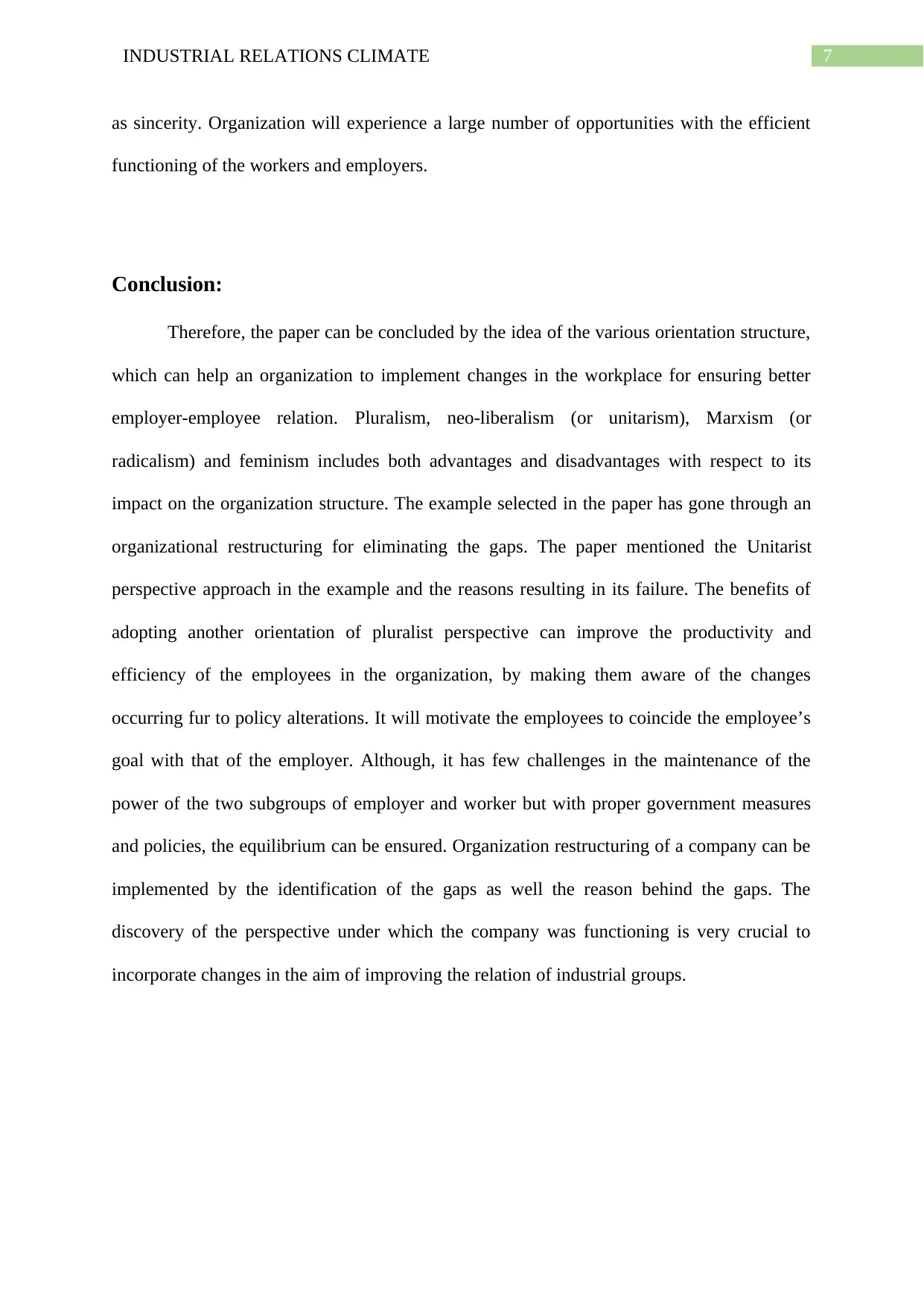
7INDUSTRIAL RELATIONS CLIMATE
as sincerity. Organization will experience a large number of opportunities with the efficient
functioning of the workers and employers.
Conclusion:
Therefore, the paper can be concluded by the idea of the various orientation structure,
which can help an organization to implement changes in the workplace for ensuring better
employer-employee relation. Pluralism, neo-liberalism (or unitarism), Marxism (or
radicalism) and feminism includes both advantages and disadvantages with respect to its
impact on the organization structure. The example selected in the paper has gone through an
organizational restructuring for eliminating the gaps. The paper mentioned the Unitarist
perspective approach in the example and the reasons resulting in its failure. The benefits of
adopting another orientation of pluralist perspective can improve the productivity and
efficiency of the employees in the organization, by making them aware of the changes
occurring fur to policy alterations. It will motivate the employees to coincide the employee’s
goal with that of the employer. Although, it has few challenges in the maintenance of the
power of the two subgroups of employer and worker but with proper government measures
and policies, the equilibrium can be ensured. Organization restructuring of a company can be
implemented by the identification of the gaps as well the reason behind the gaps. The
discovery of the perspective under which the company was functioning is very crucial to
incorporate changes in the aim of improving the relation of industrial groups.
as sincerity. Organization will experience a large number of opportunities with the efficient
functioning of the workers and employers.
Conclusion:
Therefore, the paper can be concluded by the idea of the various orientation structure,
which can help an organization to implement changes in the workplace for ensuring better
employer-employee relation. Pluralism, neo-liberalism (or unitarism), Marxism (or
radicalism) and feminism includes both advantages and disadvantages with respect to its
impact on the organization structure. The example selected in the paper has gone through an
organizational restructuring for eliminating the gaps. The paper mentioned the Unitarist
perspective approach in the example and the reasons resulting in its failure. The benefits of
adopting another orientation of pluralist perspective can improve the productivity and
efficiency of the employees in the organization, by making them aware of the changes
occurring fur to policy alterations. It will motivate the employees to coincide the employee’s
goal with that of the employer. Although, it has few challenges in the maintenance of the
power of the two subgroups of employer and worker but with proper government measures
and policies, the equilibrium can be ensured. Organization restructuring of a company can be
implemented by the identification of the gaps as well the reason behind the gaps. The
discovery of the perspective under which the company was functioning is very crucial to
incorporate changes in the aim of improving the relation of industrial groups.
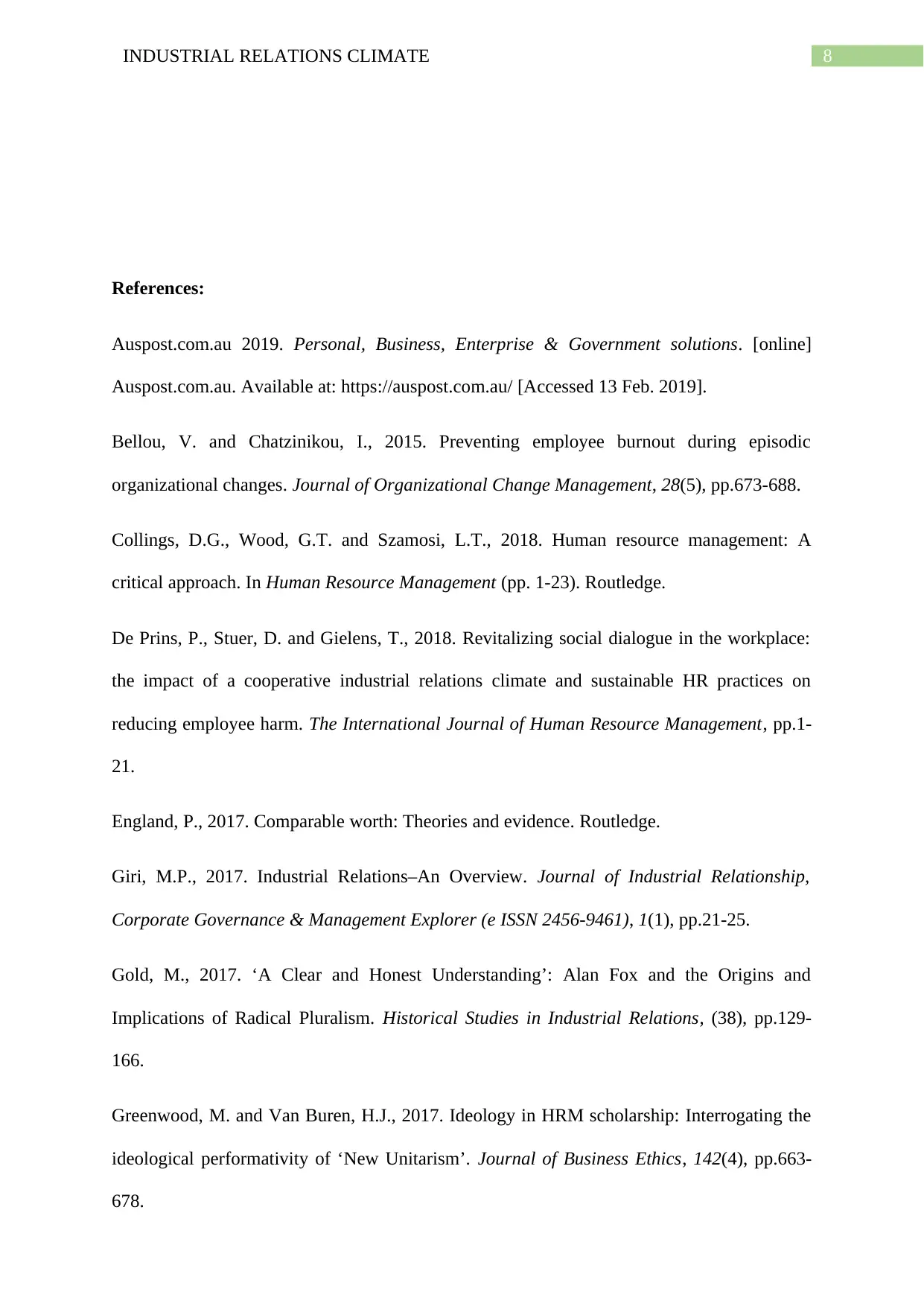
8INDUSTRIAL RELATIONS CLIMATE
References:
Auspost.com.au 2019. Personal, Business, Enterprise & Government solutions. [online]
Auspost.com.au. Available at: https://auspost.com.au/ [Accessed 13 Feb. 2019].
Bellou, V. and Chatzinikou, I., 2015. Preventing employee burnout during episodic
organizational changes. Journal of Organizational Change Management, 28(5), pp.673-688.
Collings, D.G., Wood, G.T. and Szamosi, L.T., 2018. Human resource management: A
critical approach. In Human Resource Management (pp. 1-23). Routledge.
De Prins, P., Stuer, D. and Gielens, T., 2018. Revitalizing social dialogue in the workplace:
the impact of a cooperative industrial relations climate and sustainable HR practices on
reducing employee harm. The International Journal of Human Resource Management, pp.1-
21.
England, P., 2017. Comparable worth: Theories and evidence. Routledge.
Giri, M.P., 2017. Industrial Relations–An Overview. Journal of Industrial Relationship,
Corporate Governance & Management Explorer (e ISSN 2456-9461), 1(1), pp.21-25.
Gold, M., 2017. ‘A Clear and Honest Understanding’: Alan Fox and the Origins and
Implications of Radical Pluralism. Historical Studies in Industrial Relations, (38), pp.129-
166.
Greenwood, M. and Van Buren, H.J., 2017. Ideology in HRM scholarship: Interrogating the
ideological performativity of ‘New Unitarism’. Journal of Business Ethics, 142(4), pp.663-
678.
References:
Auspost.com.au 2019. Personal, Business, Enterprise & Government solutions. [online]
Auspost.com.au. Available at: https://auspost.com.au/ [Accessed 13 Feb. 2019].
Bellou, V. and Chatzinikou, I., 2015. Preventing employee burnout during episodic
organizational changes. Journal of Organizational Change Management, 28(5), pp.673-688.
Collings, D.G., Wood, G.T. and Szamosi, L.T., 2018. Human resource management: A
critical approach. In Human Resource Management (pp. 1-23). Routledge.
De Prins, P., Stuer, D. and Gielens, T., 2018. Revitalizing social dialogue in the workplace:
the impact of a cooperative industrial relations climate and sustainable HR practices on
reducing employee harm. The International Journal of Human Resource Management, pp.1-
21.
England, P., 2017. Comparable worth: Theories and evidence. Routledge.
Giri, M.P., 2017. Industrial Relations–An Overview. Journal of Industrial Relationship,
Corporate Governance & Management Explorer (e ISSN 2456-9461), 1(1), pp.21-25.
Gold, M., 2017. ‘A Clear and Honest Understanding’: Alan Fox and the Origins and
Implications of Radical Pluralism. Historical Studies in Industrial Relations, (38), pp.129-
166.
Greenwood, M. and Van Buren, H.J., 2017. Ideology in HRM scholarship: Interrogating the
ideological performativity of ‘New Unitarism’. Journal of Business Ethics, 142(4), pp.663-
678.
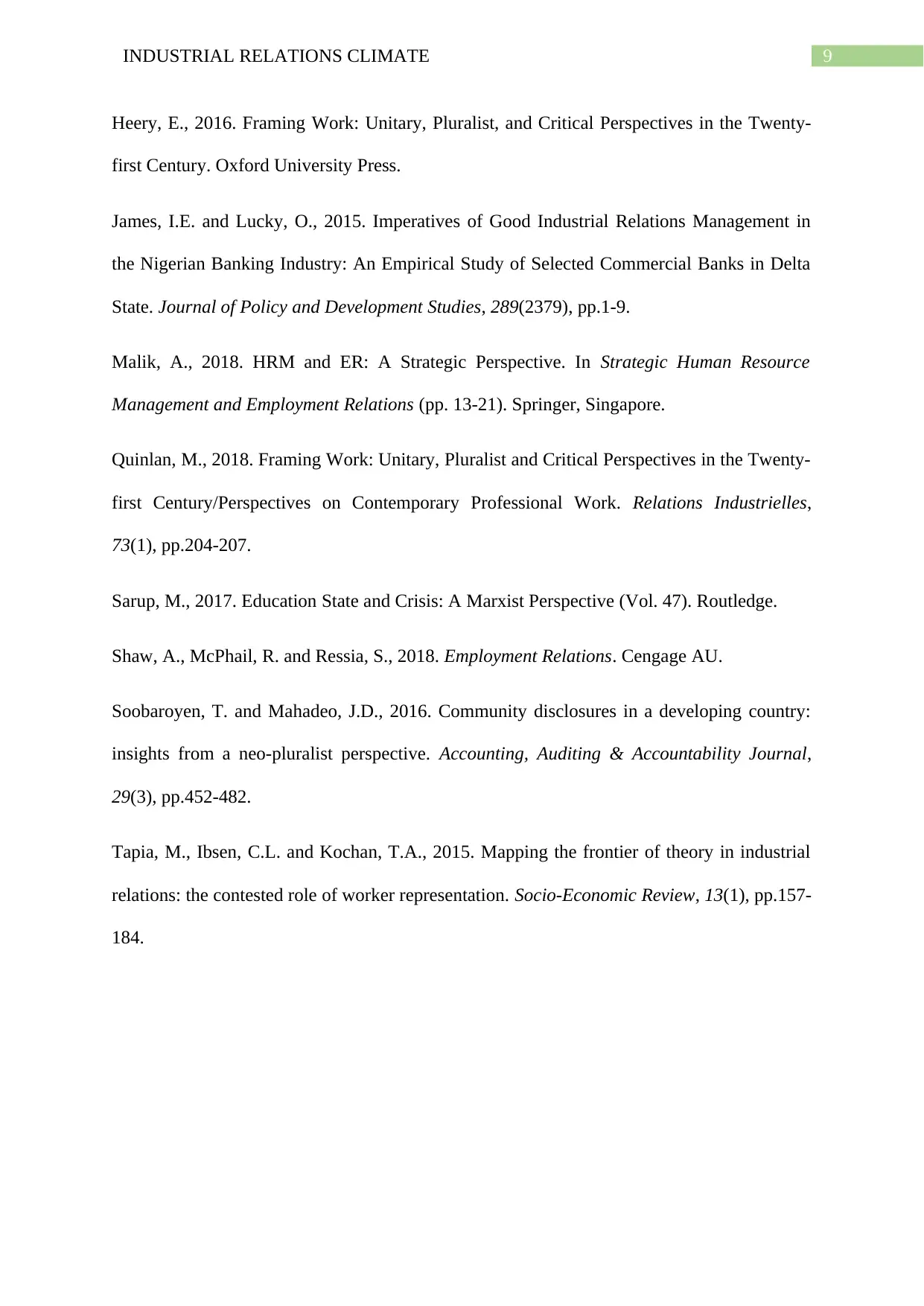
9INDUSTRIAL RELATIONS CLIMATE
Heery, E., 2016. Framing Work: Unitary, Pluralist, and Critical Perspectives in the Twenty-
first Century. Oxford University Press.
James, I.E. and Lucky, O., 2015. Imperatives of Good Industrial Relations Management in
the Nigerian Banking Industry: An Empirical Study of Selected Commercial Banks in Delta
State. Journal of Policy and Development Studies, 289(2379), pp.1-9.
Malik, A., 2018. HRM and ER: A Strategic Perspective. In Strategic Human Resource
Management and Employment Relations (pp. 13-21). Springer, Singapore.
Quinlan, M., 2018. Framing Work: Unitary, Pluralist and Critical Perspectives in the Twenty-
first Century/Perspectives on Contemporary Professional Work. Relations Industrielles,
73(1), pp.204-207.
Sarup, M., 2017. Education State and Crisis: A Marxist Perspective (Vol. 47). Routledge.
Shaw, A., McPhail, R. and Ressia, S., 2018. Employment Relations. Cengage AU.
Soobaroyen, T. and Mahadeo, J.D., 2016. Community disclosures in a developing country:
insights from a neo-pluralist perspective. Accounting, Auditing & Accountability Journal,
29(3), pp.452-482.
Tapia, M., Ibsen, C.L. and Kochan, T.A., 2015. Mapping the frontier of theory in industrial
relations: the contested role of worker representation. Socio-Economic Review, 13(1), pp.157-
184.
Heery, E., 2016. Framing Work: Unitary, Pluralist, and Critical Perspectives in the Twenty-
first Century. Oxford University Press.
James, I.E. and Lucky, O., 2015. Imperatives of Good Industrial Relations Management in
the Nigerian Banking Industry: An Empirical Study of Selected Commercial Banks in Delta
State. Journal of Policy and Development Studies, 289(2379), pp.1-9.
Malik, A., 2018. HRM and ER: A Strategic Perspective. In Strategic Human Resource
Management and Employment Relations (pp. 13-21). Springer, Singapore.
Quinlan, M., 2018. Framing Work: Unitary, Pluralist and Critical Perspectives in the Twenty-
first Century/Perspectives on Contemporary Professional Work. Relations Industrielles,
73(1), pp.204-207.
Sarup, M., 2017. Education State and Crisis: A Marxist Perspective (Vol. 47). Routledge.
Shaw, A., McPhail, R. and Ressia, S., 2018. Employment Relations. Cengage AU.
Soobaroyen, T. and Mahadeo, J.D., 2016. Community disclosures in a developing country:
insights from a neo-pluralist perspective. Accounting, Auditing & Accountability Journal,
29(3), pp.452-482.
Tapia, M., Ibsen, C.L. and Kochan, T.A., 2015. Mapping the frontier of theory in industrial
relations: the contested role of worker representation. Socio-Economic Review, 13(1), pp.157-
184.
Secure Best Marks with AI Grader
Need help grading? Try our AI Grader for instant feedback on your assignments.

10INDUSTRIAL RELATIONS CLIMATE
1 out of 11
Related Documents
Your All-in-One AI-Powered Toolkit for Academic Success.
+13062052269
info@desklib.com
Available 24*7 on WhatsApp / Email
![[object Object]](/_next/static/media/star-bottom.7253800d.svg)
Unlock your academic potential
© 2024 | Zucol Services PVT LTD | All rights reserved.





